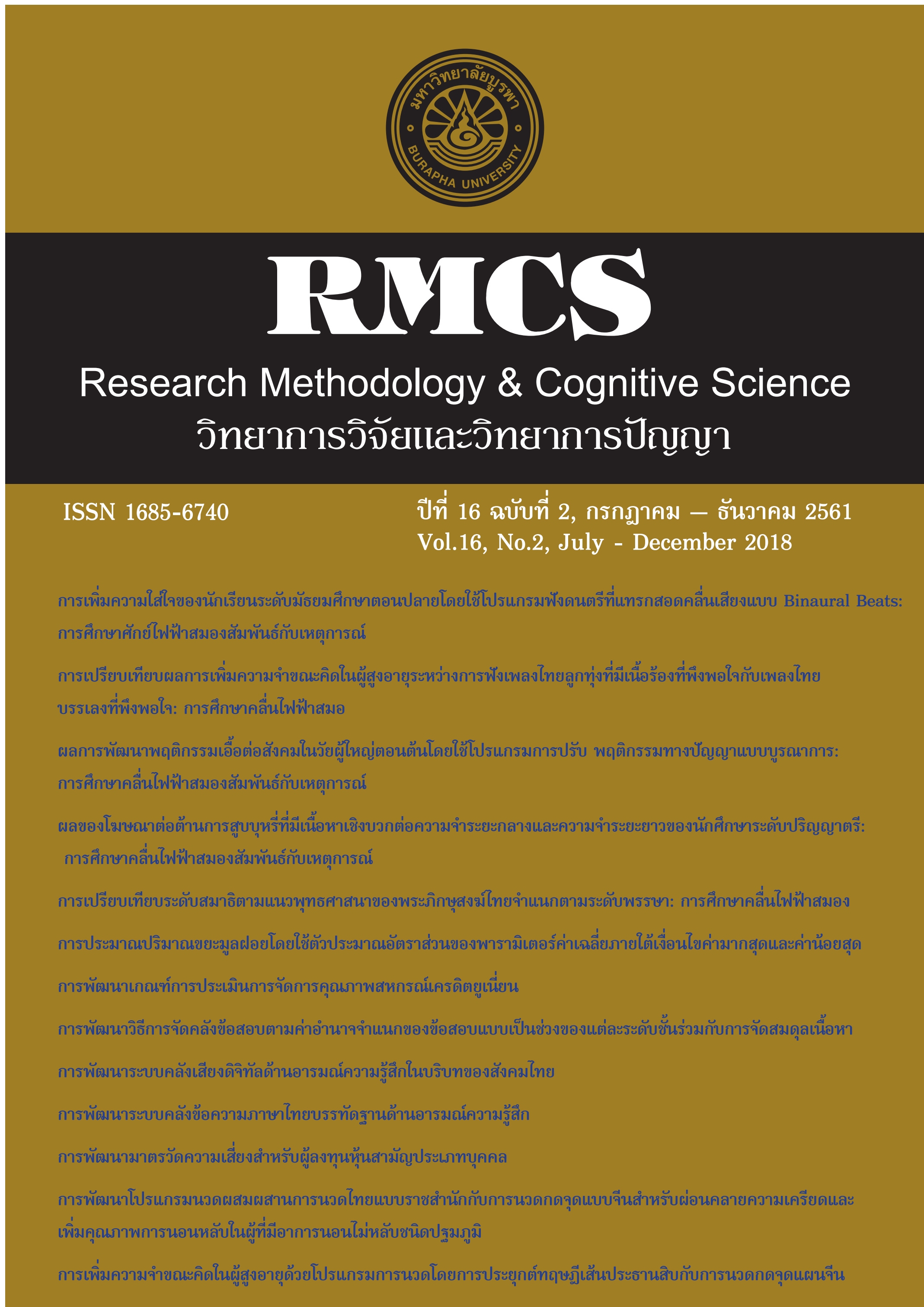The Development of a Risk - Assessment Scale for Individual Common Stock Investors (RAS)
Main Article Content
Abstract
The purposes of this research were to develop a Risk - Assessment Scale for Individual Common Stock Investors (RAS). The samples were 905 of Thai investors age 20 and above in 2018. There are three phases of research: 1) to construct a good quality items for RAS, samples were 850, 2) to construct an item bank for RAS, and 3) to derive norms for RAS, samples were 500. Testing of reliability, samples were 55. The research results revealed that
1) There were 26 good quality items for RAS that were analyzed by Graded Response Model. RAS composed of 19 items for the ability to take risk, and 7 items for the willingness to take risk.
2) The construct validity of RAS was confirmed by alignment with the criterion with Chi-square goodness of fit test value = 34.30, df = 16, AGFI= .96, and CFI =.93.
3) The norms of RAS were divided into 5 levels: 1) percentile rank 19 and below indicating Low Risk of invesment in common stocks, 2) percentile rank from 20 to 39 indicating Moderate - Low Risk of invesment in common stocks, 3) percentile rank from 40 to 60 indicating Moderate - High Risk of invesment in common stocks, 4) percentile rank from 61 to 80 indicating High Risk of invesment in common stocks, and 5) percentile rank 81 and above indicating very High Risk of invesment in common stocks.
Reliability of RAS was .74, and acceptable.
Article Details
References
ตลาดหลักทรัพย์แห่งประเทศไทย. (2556). ตลาดการเงินและการลงทุนในหลักทรัพย์ (พิมพ์ครั้งที่ 15). กรุงเทพฯ: บุญศิริการพิมพ์.
ตลาดหลักทรัพย์แห่งประเทศไทย. (2557). หลักสูตรทดสอบผู้แนะนำการลงทุน: การให้คำแนะนำการลงทุนที่เหมาะสม. วันที่ค้นข้อมูล 11 ธันวาคม 2559, เข้าถึงได้จาก https://www.set.or.th/professional/
Download/licence/TSI_Announcement/TSI_025_1-2557.pdf
สำนักงานคณะกรรมการกำกับหลักทรัพย์และธุรกิจหลักทรัพย์ (2556). ประกาศคณะกรรมการกำกับตลาดทุน ที่ ทธ.35/2556 เรื่องมาตรฐานการประกอบธุรกิจโครงสร้างการบริหารงาน ระบบงานและการให้บริการของผู้ประกอบธุรกิจหลักทรัพย์และผู้ประกอบธุรกิจสัญญาซื้อขายล่วงหน้า.
Ali, I. (2014). Risk Preferences of Bangladeshi Individual Investors towards Investment in Capital Market, Manarat International University Studies, 3(1), 18-26.
Bland, J. M., & Altman, D. G. (1997). Statistics notes: Cronbach's alpha. Bmj, 314(7080), 572.
Bunderson, C. V., Inouye, D. K., & Olsen, J. B. (1988). The four generations of computerized educational measurement. In R.L. Linn (Ed.), Educational Measurement (3rd ed, pp. 367-408). New York: Macmillan.
Campbell, J. Y. (2006). Household finance. The Journal of Finance, 61(4), 1553-1604.
Corter, J. E., & Chen, Y. J. (2006). Do investment risk tolerance attitudes predict portfolio risk? Journal of Business and Psychology, 20(3), 369-381.
Davey, G., (2012). Assessing Risk Tolerance. CPA Practice Management Forum, 8(9), 5-7.
Davey, G., (2015). Getting Risk Right. Investment Management Consultant Association Inc., March-April, 33-39.
De Ayala, R. J. (2009). The theory and practice of item response theory. Psychometrika, 75(4), 778-779.
Embetson, S. E., & Reise, S.P. (2000). Item response theory for psychologists. United States of America: Sage Publication.
Financial Conduct Authority. (2016). Financial Advice Market Review: Final report. Report. Financial Conduct Authority. London: Financial Conduct Authority.
Grable, J. E. (2008). Risk tolerance. In Handbook of Consumer Finance Research (pp. 3-19). New York: Springer.
Gravetter, F. J., & Forzano, L. B. (2012). Research Methods for The Behavioral Sciences. (4th ed.) Belmont, CA: Wadsworth Cengage Learning.
Hair, J. F., Black, W. C., Babin, B. J., & Anderson, R. E. (2014). Multivariate Data Analysis (7th ed.). Harlow: Pearson Education Limited.
Hambleton, R. K., & Swaminathan, H. (1985). Item Response Theory: Principles and Applications. Berlin: Springer Science & Business Media.
Hambleton, R. K., Swaminathan, H. & Rogers, H. J. (1991). Fundamentals of Item Response Theory. Thousand Oaks: Sage Publications.
Jiang, S., Wang, C., & Weiss, D. J. (2016). Sample size requirements for estimation of item parameters in the multidimensional graded response model. Frontiers in Psychology, 7, 109.
Linciano, N., & Soccorso, P. (2012). Assessing Investors' Risk Tolerance Through a Questionnaire. Rome: Commissione Nazionale per le Societa e la Borsa.
Lord, F. M. (2012). Applications of Item Response Theory to Practical Testing Problems. Abingdon: Routledge.
Markowitz, H. (1952). Portfolio selection. The Journal of Finance, 7(1), 77-91.
Michalos, A. C. (2014). Encyclopedia of Quality of Life and Well-Being Research. Dordrecht: Springer Netherlands.
Nunnally, J. C., & Bernstein, I. H. (1994). Psychological theory. New York, NY: MacGraw-Hill.
Palma, A., & Picard, N. (2010). Evaluation of MiFID Questionnaires in France. (Technical Report). Paris: Autorité des Marchés Financiers.
Roszkowski, M. J., Davey, G., & Grable, J. E. (2005). Insights from Psychology and Psychometrics on Measuring Risk Tolerance. Journal of Financial Planning, 18(4), 66-76.
Schumacker, R. E., & Lomax, R. G. (2004). A Beginner's Guide to Structural Equation Modeling. (2nd ed.). New Jersey: Lawrence Erlbaum Associates, Inc.
Tavakol, M., & Dennick, R. (2011). Making sense of Cronbach's alpha. International Journal of Medical Education, 2, 53-55.
Veld, C., & Veld-Merkoulova, Y. V. (2008). The risk perceptions of individual investors. Journal of Economic Psychology, 29(2), 226-252.
Walker, J., Bohnke, J. R., Cerny, T., & Strasser, F. (2010). Development of symptom assessments utilising item response theory and computer-adaptive testing-A practical method based on a systematic review. Critical reviews in oncology/hematology, 73(1), 47-67.

